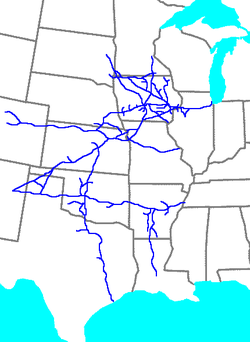Chicago, Rock Island and Pacific Railroad
 |
|

The Rock Island System in 1965.
|
|
| Reporting mark | CRIP, RI, ROCK |
|---|---|
| Locale | Arkansas, Colorado, Illinois, Iowa, Kansas, Louisiana, Minnesota, Missouri, Nebraska, New Mexico, Oklahoma, South Dakota, Tennessee, and Texas |
| Dates of operation | October 10, 1852–March 31, 1980 |
| Successor | Chicago Pacific Corporation |
| Track gauge | 4 ft 8 1⁄2 in (1,435 mm) standard gauge |
| Headquarters | Chicago, Illinois |
The Chicago, Rock Island and Pacific Railroad (CRI&P RW, sometimes called Chicago, Rock Island and Pacific Railway) (reporting marks CRIP, RI, ROCK) was a Class I railroad in the United States. It was also known as the Rock Island Line, or, in its final years, The Rock.
At the end of 1970 it operated 7183 miles of road on 10669 miles of track; that year it reported 20557 million ton-miles of revenue freight and 118 million passenger-miles. (Those totals may or may not include the former Burlington-Rock Island Railroad.)
The song "Rock Island Line", a spiritual from the late 1920s first recorded in 1934, was inspired by the railway.
Its predecessor, the Rock Island and La Salle Railroad Company, was incorporated in Illinois on February 27, 1847, and an amended charter was approved on February 7, 1851, as the Chicago and Rock Island Railroad. Construction began October 1, 1851, in Chicago, and the first train was operated on October 10, 1852, between Chicago and Joliet. Construction continued on through La Salle, and Rock Island was reached on February 22, 1854, becoming the first railroad to connect Chicago with the Mississippi River.
In Iowa, the C&RI's incorporators created (on February 5, 1853) the Mississippi and Missouri Railroad Company (M&M), to run from Davenport to Council Bluffs, and on November 20, 1855, the first train to operate in Iowa steamed from Davenport to Muscatine. The Mississippi river bridge between Rock Island and Davenport was completed on April 22, 1856.
In 1857, Abraham Lincoln represented the Rock Island in an important lawsuit regarding bridges over navigable rivers. The suit had been brought by the owner of a steamboat which was destroyed by fire after running into the Mississippi river bridge. Lincoln argued that not only was the steamboat at fault in striking the bridge but that bridges across navigable rivers were to the advantage of the country.
...
Wikipedia
